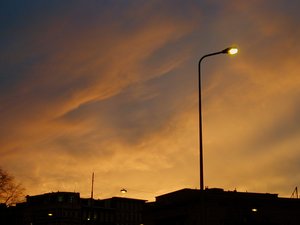Street light
|
|
A street light or street lamp, also known as a light standard, is a raised light on the edge of a road, turned on or lit at a certain time every night. Modern lamps may also have light-sensitive photocells to turn them on at dusk and off at sunrise, or activate automatically in foul weather. It is also not uncommon for street lights to be on posts which have wires strung between them (telephone poles or electrical poles).
Many residents favor street lights in their neighborhood and around town as they make it easier to navigate at night, and their proponents claim they also help reduce crime. A variety of studies have supported this view but at least one indicated that it had little or no effect. The major criticism of street lighting, however, is that it can cause light pollution, the example to the left being an example of the more egregious offenders.
Street_light.jpg
In urban areas, this light pollution can hide the stars and interfere with astronomy. In settings near astronomical telescopes and observatories, low pressure sodium lamps may be used. These lamps are advantageous over other lamps such as mercury and halogen lamps because low pressure sodium lamps emit lower intensity, monochromatic light. Observatories can filter the sodium wavelength out of their observations and virtually eliminate the interference from nearby urban lighting.
See also
External links
- Home Office Research Study 251 (PDF) (http://www.homeoffice.gov.uk/rds/pdfs2/hors251.pdf)
- The influence of street lighting on crime and fear of crime (PDF) (http://www.homeoffice.gov.uk/rds/prgpdfs/fcpu28.pdf)

